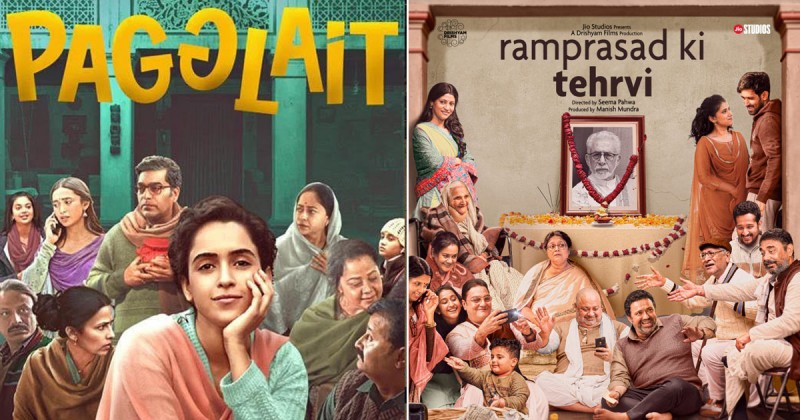
The depiction of family dynamics has frequently appeared in Indian cinema, and the recent movies "Ramprasad Ki Tehrvi" and "Pagglait" both take a fresh approach to the subject. Despite having seemingly different main characters—a deceased patriarch in one and a young man in his mid-20s in the other—both movies have an uncanny resemblance in how they portray how eccentric family members can be and how resistant they are to customary post-death rituals. This essay will examine how the films "Ramprasad Ki Tehrvi" and "Pagglait" offer a novel perspective on how families interact when a loved one passes away, as well as the subtly effective messages they deliver.
The events of "Ramprasad Ki Tehrvi," a film directed by seasoned actress Seema Pahwa, take place as the family patriarch Raamprasad (Naseeruddin Shah) passes away, setting the stage for an odd and dysfunctional family reunion. In the 13 days that follow Raamprasaad's passing, known as the Tehrvi, the family members come together to perform rituals and work through the intricate web of their connections.
The eccentric ensemble cast of "Ramprasad Ki Tehrvi," which features accomplished actors like Supriya Pathak, Vinay Pathak, Konkona Sen Sharma, and Vikrant Massey among others, is one of the film's most notable features. Each character brings their own idiosyncrasies and quirks to the screen, adding depth and authenticity to the dysfunctional family dynamic.
The movie depicts the humor, drama, and emotional turmoil that frequently accompany family reunions as they come together. The rich tapestry of personalities on display to the audience includes the domineering older sister, the struggling artist, the promiscuous brother, and the reclusive aunt. Their peculiarities and eccentricities serve as both comic relief and a lens through which the audience can consider their own family dynamics.
The movie includes customary post-death rituals and ceremonies, but it also emphasizes how the family is not particularly interested in following these traditions to the letter. There are humorous and thought-provoking moments as a result of the characters' refusal to live up to social expectations. This break with tradition is meant to be a commentary on how Indian families are changing in modern society.
By subtly challenging the rigid expectations and norms surrounding death and mourning, "Ramprasad Ki Tehrvi" invites viewers to consider the applicability of some traditions in the contemporary era. It implies that the spirit of honoring the dead and remembering them can exist outside the boundaries of customary rituals.
The main character of Umesh Bist's film "Pagglait," a young widow named Sandhya (Sanya Malhotra) in her mid-20s, appears to be very different from "Ramprasad Ki Tehrvi" on the surface. However, 'Pagglait' explores the eccentricities and idiosyncrasies of a family dealing with the aftermath of a death, albeit in a modern urban setting, much like its counterpart.
In "Pagglait," the family gathers to lament the untimely passing of Sandhya's husband, Astik. There are many people in this diverse group, including parents, in-laws, cousins, and other relatives, all of whom have their own distinct personalities and viewpoints.
The portrayal of a contemporary, urban Indian family that doesn't always adhere to traditional norms is what sets "Pagglait" apart. In the wake of Astik's passing, the family members display a range of emotions, including grief, shock, indifference, and even curiosity. These responses show how complicated human emotions can be when experiencing loss.
'Pagglait' explores the family's resistance to conventional rituals and expectations, much like 'Ramprasad Ki Tehrvi' did. The young widow Sandhya is not a stereotypical example of a grieving widow. She doesn't follow the traditional roles and conduct that society would normally expect from a woman. Her disregard for some social norms, such as wearing white, arouses intrigue and prompts inquiries about societal expectations.
The movie highlights how grief is a very individualized experience and challenges the traditional way widowhood is portrayed in Indian cinema. It implores viewers to reconsider societal norms and expectations, arguing that people ought to have the freedom to deal with their grief in a way that feels true to them.
While "Ramprasad Ki Tehrvi" and "Pagglait" have different main characters and plots, they have something in common in how they portray eccentric family members and how they dislike customary funeral rites. Both movies question societal norms and subvert expectations in order to get viewers to reevaluate how we handle things like death, grief, and family dynamics.
Ramprasad Ki Tehrvi and Pagglait invite viewers to reflect on their own familial experiences and consider how the quirks and eccentricities of family members shape our understanding of life, death, and the ties that bind us through humor, drama, and genuine emotion.
The films "Pagglait" and "Ramprasad Ki Tehrvi" offer new and perceptive perspectives on how families interact when a member is grieving. These movies offer a lens through which we can examine the changing dynamics of family relationships and societal norms surrounding death and mourning because of their eccentric characters and subversion of tradition.
The eccentricities of a large, traditional family are explored in "Ramprasad Ki Tehrvi," whereas "Pagglait" delves into the complexities of a contemporary, urban family. Despite these differences, both movies exhort us to accept the peculiarities and flaws of our own families and to acknowledge that the value of family and the significance of individual agency are sometimes only revealed in hindsight.
Shah Rukh Khan's "Jawan" Sees a Drop in Global Box Office Numbers on Day 2
A Glimpse into Bollywood's Politics: Saif Ali Khan and 'Aa Gale Lag Jaa'